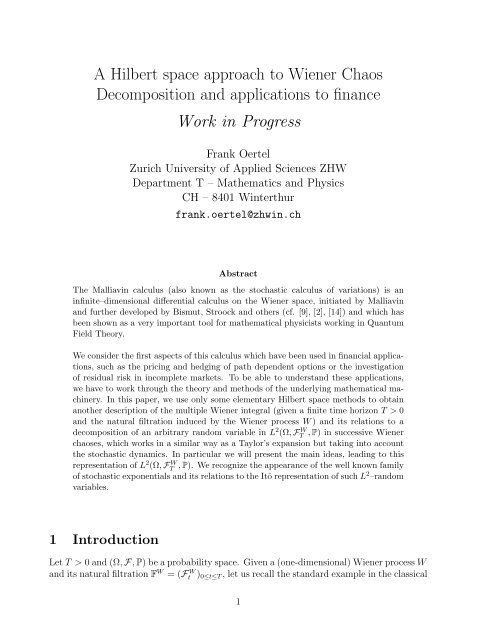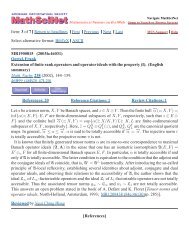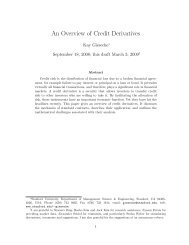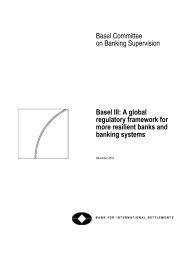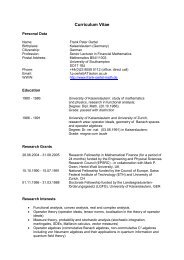Work in Progress - Frank Oertel's Homepage
Work in Progress - Frank Oertel's Homepage
Work in Progress - Frank Oertel's Homepage
Create successful ePaper yourself
Turn your PDF publications into a flip-book with our unique Google optimized e-Paper software.
A Hilbert space approach to Wiener Chaos<br />
Decomposition and applications to f<strong>in</strong>ance<br />
<strong>Work</strong> <strong>in</strong> <strong>Progress</strong><br />
<strong>Frank</strong> Oertel<br />
Zurich University of Applied Sciences ZHW<br />
Department T – Mathematics and Physics<br />
CH – 8401 W<strong>in</strong>terthur<br />
frank.oertel@zhw<strong>in</strong>.ch<br />
Abstract<br />
The Malliav<strong>in</strong> calculus (also known as the stochastic calculus of variations) is an<br />
<strong>in</strong>f<strong>in</strong>ite–dimensional differential calculus on the Wiener space, <strong>in</strong>itiated by Malliav<strong>in</strong><br />
and further developed by Bismut, Stroock and others (cf. [9], [2], [14]) and which has<br />
been shown as a very important tool for mathematical physicists work<strong>in</strong>g <strong>in</strong> Quantum<br />
Field Theory.<br />
We consider the first aspects of this calculus which have been used <strong>in</strong> f<strong>in</strong>ancial applications,<br />
such as the pric<strong>in</strong>g and hedg<strong>in</strong>g of path dependent options or the <strong>in</strong>vestigation<br />
of residual risk <strong>in</strong> <strong>in</strong>complete markets. To be able to understand these applications,<br />
we have to work through the theory and methods of the underly<strong>in</strong>g mathematical mach<strong>in</strong>ery.<br />
In this paper, we use only some elementary Hilbert space methods to obta<strong>in</strong><br />
another description of the multiple Wiener <strong>in</strong>tegral (given a f<strong>in</strong>ite time horizon T > 0<br />
and the natural filtration <strong>in</strong>duced by the Wiener process W ) and its relations to a<br />
decomposition of an arbitrary random variable <strong>in</strong> L2 (Ω, F W T , P) <strong>in</strong> successive Wiener<br />
chaoses, which works <strong>in</strong> a similar way as a Taylor’s expansion but tak<strong>in</strong>g <strong>in</strong>to account<br />
the stochastic dynamics. In particular we will present the ma<strong>in</strong> ideas, lead<strong>in</strong>g to this<br />
representation of L 2 (Ω, F W T<br />
, P). We recognize the appearance of the well known family<br />
of stochastic exponentials and its relations to the Itô representation of such L 2 –random<br />
variables.<br />
1 Introduction<br />
Let T > 0 and (Ω, F, P) be a probability space. Given a (one-dimensional) Wiener process W<br />
and its natural filtration F W = (F W t )0≤t≤T , let us recall the standard example <strong>in</strong> the classical<br />
1
Black & Scholes-market (without transaction costs), where the stock price S is modelled as<br />
dSt = µSt dt + σSt dWt and the price of the riskless asset is given by dBt = rBt dt, where<br />
µ, σ ∈ R, σ �= 0 and r ≥ 0. Then it is well known that there exists an eqivalent mart<strong>in</strong>gale<br />
measure (EMM) Q ∼ P so that Bt := Wt + µ−r<br />
t def<strong>in</strong>es a standard Q-Wiener Process B (so<br />
σ<br />
that FW = FB ) and � St := exp(−rt) St def<strong>in</strong>es a Q-mart<strong>in</strong>gale � S, which implies that every<br />
cont<strong>in</strong>gent claim Z ∈ L2 (Ω, F B T , Q) can be replicated by a self-f<strong>in</strong>anc<strong>in</strong>g portfolio and that<br />
the value of any replicat<strong>in</strong>g self-f<strong>in</strong>anc<strong>in</strong>g portfolio Π at time t is given by<br />
Πt = EQ(e −r(T −t) Z | F B t ) .<br />
The existence of such a replicat<strong>in</strong>g portfolio follows by the Kunita-Watanabe representation<br />
theorem - applied to the the Q−square-<strong>in</strong>tegrable mart<strong>in</strong>gale Π (cf. [7]):<br />
Theorem 1.1 Let M = (Mt)0≤t≤T be a square-<strong>in</strong>tegrable mart<strong>in</strong>gale, with respect to the<br />
filtration F B . Then there exists an adapted process K so that EQ( � T<br />
0 K2 s ds) < ∞ and<br />
for all t ∈ [0, T ].<br />
� t<br />
Mt = M0 + Ks dBs<br />
0<br />
Corrolary 1.1 Let Z ∈ L2 (Ω, F B T , Q). Then there exists an adapted process L so that<br />
EQ( � T<br />
0 L2s ds) < ∞ and<br />
Z = EQ(Z) +<br />
� T<br />
0<br />
Ls dBs .<br />
Unfortunately, this is only a statement lead<strong>in</strong>g to the existence of a hedg<strong>in</strong>g strategy H :=<br />
K/σ � S, which <strong>in</strong> general does not tell us, how this portfolio looks like. However, if the<br />
cont<strong>in</strong>gent claim Z can be written as Z = f(ST ), (e.g., if Z is a standard Call option) we<br />
can express the portfolio value Πt as a sufficiently smooth function of t and St, Πt = F (t, St),<br />
and an application of Itô’s formula leads to the concrete value Ht = ∂F<br />
∂x (t, St) - satisfy<strong>in</strong>g<br />
trader’s needs. Here, Malliav<strong>in</strong> calculus enters the scene. Due to this calculus, it is possible<br />
to transfer the Kunita-Watanabe representation to random variables which are functionals<br />
of Brownian motion. It turns out that the process L <strong>in</strong> the previous corollary can be<br />
identified as the optional projection of the Malliav<strong>in</strong> derivative process (DtF )0≤t≤T of F .<br />
In these lecture notes we f<strong>in</strong>ally expla<strong>in</strong> the construction of such an derivative1 and prove<br />
and formulate precisely the follow<strong>in</strong>g (cf. [5])<br />
Theorem 1.2 Let Z = F (B) be a functional of the Brownian motion B. Then, under<br />
technical hypotheses on F<br />
Z = EQ(Z) +<br />
� T<br />
0<br />
EQ(DsF | F B s ) dBs .<br />
1 This means, that we want to ”differentiate” F with respect to the chance variable ω ∈ Ω - without<br />
assum<strong>in</strong>g any topological structure on Ω.<br />
2
This result, built on deep theorems <strong>in</strong> Malliav<strong>in</strong> calculus, directly lead to applications <strong>in</strong><br />
f<strong>in</strong>ance, such as the construction of hedg<strong>in</strong>g portfolios of certa<strong>in</strong> exotic options or the <strong>in</strong>vestigation<br />
of discont<strong>in</strong>uous path-dependent payoff functionals of multidimensional diffusion<br />
processes (cf. [1], [3], [4]). A general approach to the analysis of dynamic hedg<strong>in</strong>g portfolos<br />
is discussed <strong>in</strong> [8]. The common source of these papers (and the basics of the Malliav<strong>in</strong><br />
calculus) is the nontrivial fact that option prices can be decomposed <strong>in</strong> Wiener chaoses.<br />
This chaotic decomposition works <strong>in</strong> a similar way as a Taylor’s power series expansion <strong>in</strong><br />
complex analysis, tak<strong>in</strong>g additionally <strong>in</strong>to account the stochastic dynamics of the underly<strong>in</strong>g<br />
asset price process. As <strong>in</strong> complex analysis, we will see, that the Malliav<strong>in</strong> derivative allows<br />
us to differentiate piecewise ”power series” (<strong>in</strong> L 2 (Ω)), and we will obta<strong>in</strong> the Itô <strong>in</strong>tegral as<br />
a special case of the Skorohod <strong>in</strong>tegral, which is the adjo<strong>in</strong>t of the Malliav<strong>in</strong> derivative operator.<br />
S<strong>in</strong>ce the Wiener chaos decomposition plays the crucial role <strong>in</strong> the Malliav<strong>in</strong> calculus,<br />
we give a detailed <strong>in</strong>troduction to it, <strong>in</strong>clud<strong>in</strong>g complete proofs. We only use elementary<br />
facts of Hilbert space theory. Nevertheless, our (analytic) proofs could lead to a transfer to<br />
more general semimart<strong>in</strong>gales than Brownian motion.<br />
2 The construction of the multiple Wiener <strong>in</strong>tegral<br />
Let T > 0 fixed and n ∈ N. Let f ∈ L2 (Sn(T )), where Sn(T ) := {(t1, t2,..., tn) ∈ [0, T ] n :<br />
t1 ≤ t2 ≤ ...tn} denotes the n− simplex <strong>in</strong> the cube [0, T ] n . Let W be a Wiener process<br />
(Brownian motion) and FW = (F W t )0≤t≤T the usual W -augmented filtration. We want to<br />
construct an iterated Itô-<strong>in</strong>tegral, <strong>in</strong> the follow<strong>in</strong>g sense<br />
Jnf =<br />
� T<br />
0<br />
(<br />
� tn<br />
0<br />
...(<br />
� t2<br />
0<br />
f(t1, t2, ..., tn)dWt1)...dWtn−1)dWtn . (1)<br />
To prove and understand the existence of (1), we use the well known Hilbert space approach<br />
to the Itô-<strong>in</strong>tegral. So let us recall the basic Hilbert spaces which lead to the fundamental Itô<br />
isometry: L2 (Ω × [0, T ], PW , λT ⊗ P) = : L2 T (W ) is the Hilbert space of all predictable pro-<br />
cesses X with �X� 2<br />
L 2 T (W ) = E( � T<br />
0 X2 s ds) < ∞, where P W denotes the predictable σ−algebra,<br />
i.e., the σ−algebra, generated by all left-cont<strong>in</strong>uous and F W -adapted processes. S<strong>in</strong>ce W<br />
is (left-)cont<strong>in</strong>uous, F W -adapted processes and F W -predictable processes co<strong>in</strong>cide. If X ∈<br />
L 2 T (W ), then it is well known, that the stochastic <strong>in</strong>tegral X • W = (� t<br />
0 Xs dWs)0≤t≤T is<br />
a L2 (Ω)-bounded (and cont<strong>in</strong>uous) mart<strong>in</strong>gale: X • W ∈ M 2 T (W ) := {Z : Z is a FW -<br />
mart<strong>in</strong>gale and sup E(Z<br />
0≤s≤T<br />
2 s ) < ∞}. Thus, it is an uniformly <strong>in</strong>tegrable and (<strong>in</strong> particular)<br />
closable mart<strong>in</strong>gale with clos<strong>in</strong>g element (X • W )T = � T<br />
0 XsdWs ∈ L2 (Ω, F W T , P). Let us<br />
recall the follow<strong>in</strong>g<br />
Theorem 2.1 (Itô Isometry) L2 1<br />
T (W ) ↩→ L2 (Ω, F W T , P), X ↦→ (X • W )T<br />
l<strong>in</strong>ear embedd<strong>in</strong>g:<br />
is an isometric<br />
E((X • W ) 2 � T<br />
T ) = E(<br />
0<br />
X 2 s ds).<br />
Let L2 0(Ω, F W T , P) := {X ∈ L2 (Ω) : E(X) = 0}. Then L2 0(Ω, F W T , P) obviously is a subspace of<br />
the Hilbert space L2 (Ω, F W T , P), and the Kunita-Watanabe representation theorem, together<br />
with the Itô isometry now reveal the small ”size” of the space L2 T (W ) of all square <strong>in</strong>tegrable<br />
FW -adapted processes:<br />
3
Theorem 2.2 L2 T (W ) ∼ = L2 0(Ω, F W T , P).<br />
To construct the iterated Itô <strong>in</strong>tegral recursively, we first take a closer look at the f<strong>in</strong>ite<br />
dimensional simplexes. So, let k ≥ 2 be an arbitrary natural number and t > 0. Given a<br />
function g : R k −→ R, we set g(·, s)(u) := g(u, s), where u ∈ R k−1 and s ∈ R. S<strong>in</strong>ce<br />
1lSk(t)(u, s) = 1lSk−1(s)(u) · 1l[0,t](s)<br />
for all (u, s) ∈ Sk(t), Fub<strong>in</strong>i’s theorem directly leads to the follow<strong>in</strong>g<br />
Lemma 2.1 If g ∈ L 2 (Sk(t)), then g(·, s) ∈ L 2 (Sk−1(s)) for all s ∈ [0, t], and<br />
�<br />
Sk(t)<br />
g(v) d k v =<br />
�t<br />
0<br />
� �<br />
Sk−1(s)<br />
g(u, s) d k−1 �<br />
u ds .<br />
The above isometry and Fub<strong>in</strong>i-allowed <strong>in</strong>terchang<strong>in</strong>g of the operators E and � t<br />
, now lead<br />
0<br />
us to a precise mean<strong>in</strong>g of the iterated Itô-<strong>in</strong>tegral. Given an arbitrary t > 0, we will def<strong>in</strong>e<br />
l<strong>in</strong>ear isometries Y (k) : L2 (Sk(t)) → L2 t (W ) recursively by2 and<br />
Y (1) g(ω, s) := g(s) (s ∈ [0, t]) [determ<strong>in</strong>istic]<br />
Y (k) g(ω, s) := (Y (k−1) g(·, s) • W )s(ω) (s ∈ [0, t])<br />
for k > 1. The next proposition will show us that these operators are well def<strong>in</strong>ed.<br />
Proposition 2.1 Let k, l ∈ N and t > 0. Then Y (k) : L 2 (Sk(t)) → L 2 t (W ) def<strong>in</strong>es a l<strong>in</strong>ear<br />
isometry from the Hilbert space L 2 (Sk(t)) <strong>in</strong>to the Hilbert space L 2 t (W ) and, if k �= l, then<br />
(Y (k) g | Y (l) h) L 2 t (W ) = 0 for all g ∈ L 2 (Sk(t)) and h ∈ L 2 (Sl(t)). (2)<br />
Proof: Noth<strong>in</strong>g is to show for k = 1. So let g ∈ L2 (Sk+1(t)) given and the l<strong>in</strong>ear<br />
isometry Y (k) : L2 (Sk(s)) → L2 s(W ) already be constructed (for arbitrary s ∈ [0, T ]). Let<br />
s ∈ [0, t]. Fub<strong>in</strong>i’s theorem implies that g(·, s) ∈ L2 (Sk(s)), so that Y (k) g(·, s) • W ∈ M 2 s (W )<br />
exists. Hence, sett<strong>in</strong>g (Y (k+1) g)s := (Y (k) g(·, s)•W )s = � s<br />
0 (Y (k) g(·, s))u dWu ∈ L2 (Ω, F W s , P),<br />
the previous considerations show that<br />
E(<br />
� t<br />
0<br />
(Y (k+1) g) 2 s ds) =<br />
� t<br />
0<br />
E((Y (k+1) g) 2 s) ds =<br />
� t<br />
0<br />
(E(<br />
� s<br />
0<br />
(Y (k) g(·, s)) 2 u) du) ds.<br />
By assumption, E( � s<br />
0 (Y (k) g(·, s)) 2 u) du = �<br />
Sk(s) g2 (u, s) dku, and it follows that<br />
�<br />
�Y (k+1) g� 2<br />
L2 t (W ) =<br />
Sk+1(t)<br />
g 2 (v) d k+1 v = �g� 2<br />
L2 (Sk+1(t)) < ∞.<br />
Now we will prove (2). Given m ∈ N, we have to show that (Y (k) g | Y (k+m) h) L 2 t (W ) = 0 for<br />
all k ∈ N. First, let k = 1. Then (Y (1) g | Y (1+m) h) L 2 t (W )<br />
2 More precisely, we should use the symbol Y (k)<br />
t<br />
to denote the dependence on the parameter t.<br />
4
= E( � t<br />
0 g(s) · (Y (1+m) h)s ds) = � t<br />
0 g(s) · E((Y (1+m) h)s) ds = 0, s<strong>in</strong>ce Y (1) g = g is determ<strong>in</strong>istic<br />
and Y (m) h(·, s) • W is a mart<strong>in</strong>gale which starts at 0. Let g ∈ L 2 (Sk+1(t)) and<br />
h ∈ L 2 (Sk+1+m(t)). Then, given the assumption that (2) is valid for k, the Itô isometry<br />
implies that <strong>in</strong> particular<br />
E((Y (k+1) g)s · (Y (k+1+m) h)s) = ((Y (k+1) g)s | (Y (k+1+m) h)s) L 2 (Ω,F W s ,�)<br />
= (Y (k) g(·, s) | Y (k+m) h(·, s)) L 2 s(W )<br />
= 0<br />
for all s ∈ [0, t]. Integrat<strong>in</strong>g both sides over [0, t], f<strong>in</strong>ishes the proof. �<br />
Now we def<strong>in</strong>e for arbitrary T > 0, n ∈ N and f ∈ L 2 (Sn(T ))<br />
Jnf := (Y (n) f • W )T =<br />
� T<br />
0<br />
(Y (n) f)s dWs .<br />
Evaluat<strong>in</strong>g this expression recursively, it follows by construction that<br />
Jnf =<br />
� T<br />
0<br />
Jn−1f(·, s) dWs<br />
for all n > 1, and we obta<strong>in</strong> the above expression (1). Sett<strong>in</strong>g J0c := c for c ∈ L 2 (S0(T )) :=<br />
R, we arrive at the follow<strong>in</strong>g<br />
Theorem 2.3 Let n ∈ N0 and T > 0. Then<br />
Jn : L 2 (Sn(T )) 1<br />
↩→ L 2 (Ω, F W T , P)<br />
is a l<strong>in</strong>ear isometry, and if m ∈ N0 with m �= n, then<br />
for all f ∈ L 2 (Sn(T ) and g ∈ L 2 (Sm(T )).<br />
E(Jnf · Jmg) = (Jnf | Jmg) L 2 (Ω,F W T ,�) = 0<br />
Proof: Jn is the composition of two l<strong>in</strong>ear isometries, namely<br />
L 2 (Sn(T )) 1<br />
↩→ L 2 T (W ) ∼ = → L 2 (Ω, FT , P), f ↦→ Y (n) f ↦→ (Y (n) f • W )T<br />
Until now, we have def<strong>in</strong>ed the multiple Wiener <strong>in</strong>tegral only for functions belong<strong>in</strong>g to<br />
L 2 (Sn(T )) with given T > 0. The def<strong>in</strong>ition of the simplex Sn(T ) = {(t1, t2, ..., tn) ∈ [0, T ] n :<br />
t1 ≤ t2 ≤ ... ≤ tn} leads to the conclusion that the order structure of R n plays a fundamental<br />
role <strong>in</strong> the construction of the mutiple <strong>in</strong>tegral, but it is not really so. Let f ∈ L 2 ([0, T ] n )<br />
be a symmetric function; i.e.: f(t1, t2, ..., tn) = f(tσ(1), tσ(2), ..., tσ(n)) for all permutations<br />
σ ∈ Sn. Let � L 2 ([0, T ] n ) denote the (closed) l<strong>in</strong>ear subspace of all symmetric functions <strong>in</strong><br />
L 2 ([0, T ] n ).<br />
Proposition 2.2 Let n ∈ N and T > 0. Then 3<br />
for all f ∈ � L 2 ([0, T ] n ).<br />
�f� 2<br />
L 2 ([0,T ] n ) = n! · �f | Sn(T )� 2<br />
L 2 (Sn(T ))<br />
3 Often, we will denote f | Sn(T ) by the same symbol f, if no misunderstand<strong>in</strong>g is possible.<br />
5<br />
�<br />
(3)
Proof: Noth<strong>in</strong>g is to show for n = 1. So, let (3) be true for n ∈ N and let f ∈<br />
�L 2 ([0, T ] n+1 ). Set Hk = L2 ([0, T ] k ). Then, by <strong>in</strong>duction assumption and Fub<strong>in</strong>i<br />
�f� 2 Hn+1 =<br />
� T<br />
�f(·, s)�<br />
0<br />
2 � T<br />
Hn ds = n!<br />
0<br />
�f(·, s)� 2 �<br />
Sn(T ) ds<br />
= n! f 2 (t) d n+1 t .<br />
Now,<br />
Sn(T )×[0,T ]<br />
Sn(T ) × [0, T ] = {(τ, s) ∈ [0, T ] n+1 : τ ∈ Sn(T )} = An+1(T ) ∪ Sn+1(T ) ,<br />
where An+1(T ) := {(τ, s) ∈ [0, T ] n+1 : τ ∈ Sn(T ), s < τn}. S<strong>in</strong>ce exactly n ordered positions<br />
for such an s are possible, An+1(T ) equals to the disjo<strong>in</strong>t junion �n k=1 Λ−1<br />
k (Sn+1(T )) (a.s.),<br />
where Λk ∈ O(n + 1; R) denotes the matrix which maps the unit vector el to el if 1 ≤ l < k,<br />
el to el+1 if k ≤ l < n + 1 and en+1 to ek. S<strong>in</strong>ce f is symmetric, it follows <strong>in</strong> particular that<br />
f 2 (t) = f 2 (Λkt) for all k ∈ {1, ..., n} and t ∈ [0, T ] n+1 , so that the transformation formula<br />
implies that<br />
�<br />
�<br />
�<br />
Sn+1(T )<br />
f 2 (t) d n+1 t =<br />
Λ −1<br />
k (Sn+1(T ))<br />
f 2 (Λkt) d n+1 t =<br />
Λ −1<br />
k (Sn+1(T ))<br />
f 2 (t) d n+1 t,<br />
and the proof is f<strong>in</strong>ished. �<br />
Us<strong>in</strong>g this fact, we now transfer the def<strong>in</strong>ition of the multiple Wiener <strong>in</strong>tegral to functions<br />
f ∈ � L 2 ([0, T ] n ) <strong>in</strong> the follow<strong>in</strong>g sense:<br />
Inf := n! · Jn(f | Sn(T )).<br />
By the previous considerations, In : � L2 ([0, T ] n ) → L2 (Ω, FT , P) is a l<strong>in</strong>ear cont<strong>in</strong>uous operator,<br />
and:<br />
E((Inf) 2 ) = �Inf� 2<br />
L2 (Ω,FT ,�) = n! · �f�2L<br />
2 ([0,T ] n ) .<br />
3 Hermite Polynomials and Chaos Decomposition<br />
In the follow<strong>in</strong>g paragraph we consider functions <strong>in</strong> � L2 ([0, T ] n ) of type<br />
g ⊗n n�<br />
(x1, ..., xn) := g(xi) ,<br />
where g ∈ L 2 ([0, T ]). We will recognize that these symmetric products are the cornerstones<br />
of the factorization of L 2 (Ω, FT , P) through multiple Wiener <strong>in</strong>tegrals. To that end, let us<br />
recall the well known Hermite polynomials (n ∈ N0, x ∈ R) :<br />
i=1<br />
hn(x) := (−1) n · exp( x2<br />
2 ) · g(n) (x) ,<br />
where g(x) := exp(− x2<br />
2 ). The first Hermite polynomials are h0(x) = 1, h1(x) = x, h2(x) =<br />
x 2 − 1 and h3(x) = x 3 − 3x. Given a > 0, we put<br />
Then we have the follow<strong>in</strong>g<br />
Hn(x, a) := √ a n · hn( x √ a ).<br />
6
Lemma 3.1 Let t ∈ R, x ∈ R and a > 0. Then<br />
(i) exp(tx − t2<br />
∞� t ) = 2<br />
n=0<br />
n<br />
· hn(x)<br />
n!<br />
(ii) exp(tx − at2<br />
∞� t ) = 2<br />
n=0<br />
n<br />
n! · Hn(x, a).<br />
Proof: Let x ∈ R fixed. S<strong>in</strong>ce exp(tx − t2<br />
x2 ) = exp( 2 2 ) · (g ◦ τx)(t), where τx(t) := x − t<br />
and g(y) := exp(− y2<br />
2 ), Taylor’s formula applied to g ◦ τx leads to<br />
exp(tx − t2<br />
2<br />
) = exp(x2 ) ·<br />
2<br />
n=0<br />
∞�<br />
n=0<br />
(g ◦ τx) (n) (0)<br />
n!<br />
· t n<br />
= exp( x2<br />
∞�<br />
) · (−1)<br />
2<br />
n=0<br />
n · (g(n) ◦ τx)(0)<br />
n!<br />
∞� t<br />
=<br />
n<br />
n! · hn(x) ,<br />
and (i) is proven. Now, (ii) follows directly, by sett<strong>in</strong>g exp(tx − at2<br />
s2<br />
) = exp(sy − ), where<br />
2 2<br />
s := t √ a and y := x √ . �<br />
a<br />
Due to partial differentiation of the function (x, a) ↦→ exp(tx− at2 ), the corollary immediately<br />
2<br />
implies the important<br />
Remark 3.1 ∂<br />
∂xHn(x, a) = n · Hn−1(x, a) and ( 1<br />
2 ∂x2 + ∂<br />
∂a )Hn(x, a) = 0 on R × R ∗<br />
+ .<br />
Now we can prove the follow<strong>in</strong>g representation:<br />
Theorem 3.1 Let T > 0 and g ∈ L 2 ([0, T ]). Then g ⊗n ∈ � L 2 ([0, T ] n ) for all n ∈ N and<br />
where X := g • W .<br />
∂ 2<br />
In(g ⊗n ) = Hn(XT , 〈X, X〉T ) = Hn((g • W )T , �g� 2<br />
L2 ([0,T ] ) , (4)<br />
Proof: We will prove the statement by <strong>in</strong>duction on n. Noth<strong>in</strong>g is to show for n = 1. Let<br />
(4) be valid for n ∈ N and set φn+1 := g⊗n+1 | Sn+1(T ). Then φn+1(·, s) = (g | [0, s]) ⊗n · g(s)<br />
on Sn(s) for all s ∈ [0, T ], and the def<strong>in</strong>ition of In+1 implies that<br />
In+1g ⊗n+1 � T<br />
= (n + 1)! · Jn+1φn+1 = (n + 1)! ·<br />
� T<br />
0<br />
= (n + 1)! ·<br />
= (n + 1)! ·<br />
= (n + 1) ·<br />
= (n + 1) ·<br />
(Y (n) φn+1(·, s) • W )s dWs<br />
· t n<br />
(Y (n+1) φn+1)s dWs<br />
0<br />
� T<br />
g(s) · (Y<br />
0<br />
(n) (g | [0, s]) ⊗n • W )s dWs<br />
� T<br />
0<br />
� T<br />
0<br />
g(s) · In(g | [0, s]) ⊗n dWs<br />
g(s) · Hn(Xs , 〈X, X〉s) dWs .<br />
7
On the other hand, us<strong>in</strong>g the previous remark, Itô’s formula applied to Hn+1(XT , 〈X, X〉T )<br />
leads to<br />
Hn+1(XT , 〈X, X〉T ) =<br />
� T<br />
0<br />
= (n + 1) ·<br />
= (n + 1) ·<br />
D1Hn+1(Xs , 〈X, X〉s) dXs + 0<br />
� T<br />
0<br />
� T<br />
0<br />
Hn(Xs , 〈X, X〉s) dXs<br />
Hn(Xs , 〈X, X〉s) · g(s) dWs ,<br />
and the proof is f<strong>in</strong>ished. �<br />
Let T > 0. To prove our ma<strong>in</strong> theorem <strong>in</strong> this paragraph - the Chaos representation of L2 -,<br />
we need a deeper <strong>in</strong>vestigation of the set {exp((g •W ))T : g ∈ L2 ([0, T ])}. Let g ∈ L2 ([0, T ]).<br />
Then X := g • W ∈ M 2 T (W ) and exp(XT ) = E(X)T · exp( 1<br />
2�g�2 L2 ([0,T ]) ) is an element of<br />
L1 (Ω, FT , P) with E( exp(XT )) ≤ exp( 1<br />
2�g�2 L2 ([0,T ] ) < ∞ (s<strong>in</strong>ce E(X) is a positive supermart<strong>in</strong>gale4<br />
), but <strong>in</strong> our case, we are able to show the follow<strong>in</strong>g:<br />
Lemma 3.2<br />
(i) exp((g • W )T ) ∈ L 2 (Ω, FT , P) for all g ∈ L 2 ([0, T ]);<br />
(ii) {exp((g • W )T ) : g ∈ L 2 ([0, T ])} is total <strong>in</strong> L 2 (Ω, FT , P).<br />
Proof: ad (i): Let X = g • W . Due to Lemma 5 and the previous theorem, it follows (for<br />
t = 1) that<br />
∞� 1<br />
E(X)T =<br />
n! · Hn(XT<br />
∞� 1<br />
, < X, X >T ) =<br />
n! In(g ⊗n )<br />
n=0<br />
holds po<strong>in</strong>twise on Ω. Now we show that this convergence still holds <strong>in</strong> L2 (Ω). Let us<br />
consider the f<strong>in</strong>ite sums Zn := n� 1<br />
k! Ik(g⊗k ) = n�<br />
Jk(g⊗k | Sk(T )) and let m < n. Each<br />
k=0<br />
Zn belongs to L 2 (Ω), and it follows (by orthogonality and isometry) that �Zn − Zm� 2<br />
L 2 (Ω) =<br />
n�<br />
k=m+1<br />
1<br />
k! �g⊗k � 2<br />
L 2 (Sk(T ))<br />
= n�<br />
k=m+1<br />
k=0<br />
n=0<br />
1<br />
k! (�g�2<br />
L 2 ([0,T ]) )k . Hence (Zn) is a Cauchy sequence <strong>in</strong> L 2 (Ω),<br />
and it follows the existence of a Z ∈ L2 (Ω) so that �Zn − Z�L2 (Ω) → 0 for n → ∞. In<br />
particular, there exists a subsequence (Znk ) of (Zn) so that Z = lim Znk po<strong>in</strong>twise <strong>in</strong> Ω.<br />
k→∞<br />
Thus E(X)T = Z ∈ L 2 (Ω) and therefore exp(XT ) = Z · exp( 1<br />
2 �g�2<br />
L 2 ([0,T ] ) ∈ L2 (Ω).<br />
ad (ii): Let N be the L 2 -closure of the l<strong>in</strong>ear hull M of the set {exp((g • W )T ) : g ∈<br />
L 2 ([0, T ])}. S<strong>in</strong>ce L 2 (Ω) = N ⊕ N ⊥ and N ⊥ = M ⊥ , we only have to show that M ⊥ = 0. So<br />
let ξ ∈ M ⊥ . By l<strong>in</strong>earity of the stochastic <strong>in</strong>tegral, it follows that<br />
E(ξ · exp(<br />
n�<br />
i=1<br />
λi · (gi • W )T )) = 0<br />
4 Indeed, Novikov’s condition implies that E(X) is still an uniformly <strong>in</strong>tegrable mart<strong>in</strong>gale.<br />
8
for all n ∈ N, λ1, ..., λn ∈ R and g1, ..., gn ∈ L2 ([0, T ]). In particular we obta<strong>in</strong> for arbitrary<br />
t1, ..., tn ∈ [0, T ]<br />
E(ξ · exp((λ | Z(ω))�n)) = 0 , (5)<br />
where λ := ( λ1, ..., λn) and Z := ((1(0,t1] • W )T , ...(1(tn−1,tn] • W )T ) = (Wt1, ..., Wtn − Wtn−1).<br />
By construction of Z, w ↦→ E(ξ · exp((w | Z)�n)) is an entire function on the connected open<br />
doma<strong>in</strong> Cn , so that (5) is true for all λ ∈ Cn . Denot<strong>in</strong>g m(A) := �<br />
A ξ dP (A ∈ F W T ), it<br />
follows <strong>in</strong> particular that<br />
�<br />
0 = E(ξ · exp(i (λ | Z(ω))�n)) = exp(i (λ | Z(ω))�n) m(dω)<br />
�<br />
Ω<br />
= exp(i (λ | ρ)�n) mZ(dρ) = �mZ(λ)<br />
� n<br />
for all λ ∈ R n . In other words, the Fourier transform of the measure mZ vanishes on R n .<br />
Hence, by <strong>in</strong>jectivity of the Fourier transform, m vanishes on σ(Z) = σ(Wt1, ..., Wtn) for all<br />
t1, ..., tn ∈ [0, T ], which implies by def<strong>in</strong>ition of m, that E(1A ·ξ) = m(A) = 0 for all A ∈ F W T .<br />
Hence, ξ = 0, and the proof of the lemma is f<strong>in</strong>ished. �<br />
Now we are totally prepared to prove<br />
Theorem 3.2 (Chaos decomposition) Let T > 0 and X ∈ L2 (Ω, F W T , P). Then there<br />
exists a unique sequence (fn)n∈� of determ<strong>in</strong>istic and symmetric functions fn ∈ � L2 ([0, T ] n )<br />
so that<br />
∞�<br />
X = E(X)+<br />
and<br />
�X� 2<br />
L 2 (Ω) = E2 (X)+<br />
∞�<br />
n=1<br />
n=1<br />
Infn<br />
n! · �fn� 2<br />
L 2 ([0,T ]) .<br />
Proof: Let X ∈ L2 (Ω, F W T , P) be given. Then, by the previous lemma, there exists a<br />
sequence (Zn) belong<strong>in</strong>g to the l<strong>in</strong>ear hull of the set {exp((g • W )T ) : g ∈ L2 ([0, T ])} so that<br />
�X − Zn� 2<br />
L 2 (Ω) → 0 . Each Zn can be written as a f<strong>in</strong>ite sum of type � ln<br />
k=1 αk exp((gk • W )T )<br />
with real αk and square-<strong>in</strong>tegrable gk. By theorem 6 and the previous considerations, each<br />
stochastic exponential E(gk • W )T can be written as E(gk • W )T = ∞�<br />
m=0<br />
1 ⊗m<br />
Im(g m! k ), so that<br />
Zn = � ∞<br />
m=0 Jmφ n m with (φ n m) n∈� ⊆ L 2 (Sm(T )). Orthogonality and the isometry condition<br />
now lead to �Zi − Zj� 2<br />
L 2 (Ω) = � ∞<br />
m=0 �φi m − φ j m� 2<br />
L 2 (Sm(T )) for all i, j ∈ N. Thus, (φi m) i∈�<br />
is a L 2 (Sm(T ))-Cauchy sequence for every m ∈ N0, imply<strong>in</strong>g the existence of a limit φm<br />
∈ L 2 (Sm(T )) with �φm − φ i m� 2<br />
L 2 (Sm(T )) → 0 for i → ∞, and we obta<strong>in</strong> that � ∞<br />
m=0 �φm −<br />
φi m�2 L2 (Sm(T )) → 0 for i → ∞. Hence, by orthogonality and the isometry condition aga<strong>in</strong>,<br />
it follows the existence of Z := �∞ m=0 Jmφm = �∞ m=0 Jm(φm − φi0 m) + Zi0 ∈ L2 (Ω) (for a<br />
→ 0 for<br />
suitable i0 ∈ N), and we obta<strong>in</strong> that �Z − Zi� 2<br />
L 2 (Ω) = � ∞<br />
m=0 �φm − φ i m� 2<br />
L 2 (Sm(T ))<br />
i → ∞. By uniqueness of the limits, X = Z = � ∞<br />
m=0 Jmφm with (φm) ⊆ L 2 (Sm(T )).<br />
To f<strong>in</strong>ish our proof we first extend each φm trivially to ψm ∈ L 2 ([0, T ] m ) and consider<br />
then the symmetrization � ψm of ψm:<br />
�ψm := 1 �<br />
· ψm ◦ Aσ ∈<br />
m!<br />
σ∈�n<br />
� L2 ([0, T ] m ) ,<br />
9
where Aσ(t1, ..., tm) := (tσ(1), ..., tσ(m)) for all (t1, ..., tm) ∈ [0, T ] m . S<strong>in</strong>ce Aσ(Sm(T )) has<br />
no common po<strong>in</strong>ts with Sm(T ) for all σ �= id, the def<strong>in</strong>ition of ψm implies that (ψm ◦<br />
Aσ) | Sm(T ) = 0 for all σ �= id, so that � ψm | Sm(T ) = 1<br />
m! · φm, and we obta<strong>in</strong> that<br />
X = �∞ m=0 Jmφm = �∞ m=0 Im � ψm. Moreover, due to proposition 4, it follows that<br />
�X� 2<br />
L 2 (Ω) =<br />
∞�<br />
m=0<br />
�φm� 2<br />
L 2 (Sm(T )) =<br />
∞�<br />
m=0<br />
m! · � � ψm� 2<br />
L 2 ([0,T ] m ) .<br />
S<strong>in</strong>ce X = � ∞<br />
m=0 Jmφm = φ 0 + � ∞<br />
m=1 (Y (m) φm • W )T , we have E(X) = φ 0 + 0, and because<br />
of the orthogonal representation, uniqueness follows immediately. �<br />
References<br />
[1] H. P. Berm<strong>in</strong>. Path Dependent Options: Hedg<strong>in</strong>g Lookback and Partial Lookback Options,<br />
Prepr<strong>in</strong>t, Lund University Sweden.<br />
[2] J. M. Bismut. Mart<strong>in</strong>gales, the Malliav<strong>in</strong> calculus and hypoellipticity under general<br />
Hörmander’s conditions, Z. Wahrsch. Verw. Gebiete 56 (1981), 469-505.<br />
[3] M. Dritschel and P. Protter. Complete Markets with Discont<strong>in</strong>uous Security Price,<br />
Prepr<strong>in</strong>t, Dept. Statistics, Purdue University, West Lafayette, USA.<br />
[4] E. Fournié, J.-M. Lasry, J. Lebuchoux, P.-L. Lions, and N. Touzi. An Application of<br />
Malliav<strong>in</strong> Calculus to Monte Carlo Methods <strong>in</strong> F<strong>in</strong>ance, Forthcom<strong>in</strong>g <strong>in</strong> F<strong>in</strong>ance &<br />
Stochastics.<br />
[5] I. Karatzas, D. Ocone, and J. Li. An extension of Clark’s formula, Stochastics and<br />
Stochastic Reports, 37 (1991), 127-131.<br />
[6] N. Kazamaki. Cont<strong>in</strong>uous Exponential Mart<strong>in</strong>gales and BMO, Spr<strong>in</strong>ger, Lecture Notes<br />
<strong>in</strong> Mathematics 1579 (1994).<br />
[7] H. Kunita and S. Watanabe. On square <strong>in</strong>tegrable mart<strong>in</strong>gales, Nagoya Math. J. 30<br />
(1967), 209-245.<br />
[8] V. Lacoste. Wiener Chaos: A New Approach to Option Hedg<strong>in</strong>g, Math. F<strong>in</strong>ance, Vol 6,<br />
No. 2 (April 1996), 197–213.<br />
[9] P. Malliav<strong>in</strong>. Stochastic calculus of variations and hypoelliptic operators, Proceed<strong>in</strong>gs<br />
of the International Conference on Stochastic Differential Equations, Kyoto, 195–263,<br />
K<strong>in</strong>okuniya, Tokyo; Wiley, New York (1976)<br />
[10] P. A. Meyer. Quantum Probability for Probabilists, Spr<strong>in</strong>ger, Lecture Notes <strong>in</strong> Mathematics<br />
1538, 2nd ed. (1994).<br />
[11] D. Nualart. The Malliav<strong>in</strong> Calculus and Related Topics, Spr<strong>in</strong>ger, Probability and its<br />
Applications (1995).<br />
[12] B. Øksendal. An <strong>in</strong>troduction to Malliav<strong>in</strong> Calculus with Applications to Economics,<br />
Norwegian School of Economics and Bus<strong>in</strong>ess Adm<strong>in</strong>istration, <strong>Work</strong><strong>in</strong>g Paper no. 3/96<br />
(1996).<br />
10
[13] D. Revuz and M. Yor. Cont<strong>in</strong>uous Mart<strong>in</strong>gales and Brownian Motion, Spr<strong>in</strong>ger,<br />
Grundlehren der math. Wissensch., 2nd ed. (1994).<br />
[14] D. Stroock. The Malliav<strong>in</strong> calculus and its applications, Stochastic Integrals (Proc. Sympos.<br />
Univ. Durham, Durham 1980), 394-432, Spr<strong>in</strong>ger, Lecture Notes <strong>in</strong> Mathematics<br />
851 (1981).<br />
11


